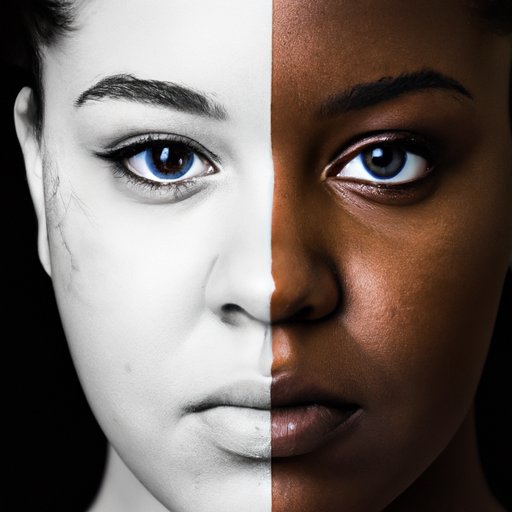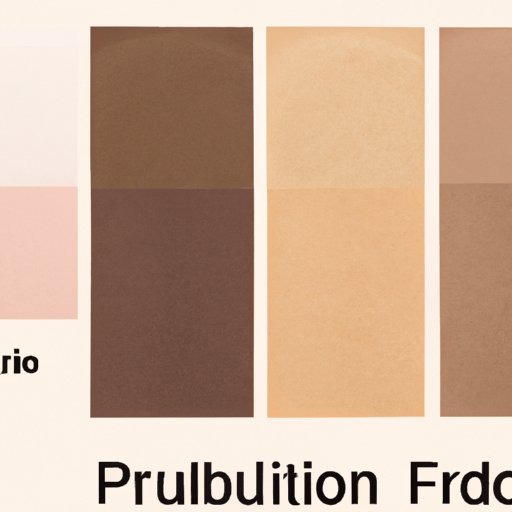Introduction
Your skin undertone is a major factor in determining the type of makeup and skincare products that work best for you. Knowing your skin’s underlying hue can help you select shades and tones that are complementary to your complexion. But what is my skin undertone? How do I determine what it is? In this article, we’ll explore the basics of skin undertones and provide a comprehensive guide on how to identify yours.
Overview of Skin Undertones
Skin undertones are the subtle hues beneath the surface of your skin. They are usually categorized into three main categories: warm, cool, and neutral. Your skin undertone will remain consistent throughout your life, even if your skin color may change due to sun exposure, illness, or other factors. It’s important to understand your skin’s undertone in order to select the right makeup and skincare products for your complexion.
Benefits of Knowing Your Skin Undertone
Knowing your skin undertone offers several advantages. First, it will make it easier to find the perfect shade of foundation for your skin. When you know your skin’s underlying hue, you can select a foundation that matches your natural coloring. Additionally, you’ll be able to choose eye shadows, blush, and lipsticks that will enhance your features without looking unnatural. Finally, understanding your skin undertone will help you decide which skincare products are best suited for your complexion.
Identify Your Skin Undertone: A Guide
Identifying your skin undertone can be tricky, but with a few simple steps, you can uncover your true hue. Here’s how to get started:
Analyzing the Surface of Your Skin
Start by examining the surface of your skin. Look at the color of your cheeks, nose, forehead, and chin. Do they appear to be pinkish, yellowish, or olive? This will give you an initial indication of your skin undertone.
Evaluating Your Natural Coloring
Next, take a look at your natural coloring. Do you have a lot of freckles? Are your eyes light or dark? Does your hair have a lot of red or gold tones? These factors can help you determine your skin undertone.
Examining Your Veins
Finally, take a look at the color of your veins. If your veins appear blue or purple, you likely have a cool skin undertone. If your veins appear green, you likely have a warm skin undertone. If your veins appear to be both green and blue, you likely have a neutral skin undertone.
How to Determine Your Skin’s Undertone
Once you’ve identified the basic color of your skin, you can use a few different techniques to determine your skin undertone. Here’s what you need to do:
Use a Mirror and Natural Light
Stand in front of a mirror in natural light and take a look at your skin. Does it appear yellowish, pinkish, or olive? This will give you a better idea of your skin’s underlying hue.
Test Different Colors Against Your Skin
Try out different colors against your skin. Hold a white piece of paper next to your face and compare the two hues. If the white looks more yellow than your skin, then you likely have a cool skin undertone. If the white looks more pink than your skin, then you likely have a warm skin undertone.
Consider Your Ethnic Background
Your ethnicity can also play a role in determining your skin undertone. For example, people of Asian descent tend to have a cool skin undertone, while people of African descent tend to have a warm skin undertone. Keep this in mind when trying to identify your skin undertone.

What You Need to Know About Skin Undertones
Now that you know how to identify your skin undertone, let’s take a look at the different types of skin undertones and what they mean.
Different Types of Skin Undertones
The three main types of skin undertones are warm, cool, and neutral. Warm skin tones have yellow or golden undertones, while cool skin tones have pink or bluish undertones. Neutral skin tones are somewhere in between, with a mix of warm and cool undertones.
Warm vs. Cool Undertones
People with warm skin tones should opt for warmer colors like oranges, yellows, and golds. People with cool skin tones should opt for cooler colors like blues, purples, and pinks. Neutral skin tones can wear either warm or cool colors depending on their individual preference.
Neutral Skin Tones
Neutral skin tones are harder to identify because they contain both warm and cool undertones. To determine your exact skin tone, try testing out different colors against your skin and see which ones look best.

The Basics of Skin Undertone
Now that you understand the different types of skin undertones, let’s take a look at the basics of skin undertone. Here are a few tips to keep in mind:
How to Select the Best Makeup for Your Skin Tone
When selecting makeup, it’s important to choose colors that complement your skin undertone. For example, people with warm skin tones should opt for warm shades of foundation, blush, and eyeshadow. People with cool skin tones should opt for cool shades. Neutral skin tones should experiment with both warm and cool shades to find the best match.
Choosing Clothing That Complements Your Skin
Clothing can also play a role in enhancing your skin tone. People with warm skin tones should opt for earthy colors like browns and greens. People with cool skin tones should opt for jewel tones like blues and purples. People with neutral skin tones can wear any color they choose.
Enhancing Your Skin With the Right Products
Using the right skincare products is essential for maintaining healthy, glowing skin. When choosing products, consider your skin type and skin undertone. For example, people with warm skin tones should opt for products that contain ingredients like aloe vera and honey, while people with cool skin tones should opt for products that contain ingredients like rosewater and lavender.
Discovering Your Skin Undertone
If you’re still unsure of your skin undertone, there are several ways to find out. Here are a few options:
Take an Online Quiz
There are many online quizzes that can help you determine your skin undertone. Most of these quizzes ask questions about your natural coloring and the color of your veins. After completing the quiz, you’ll receive a personalized report that outlines your skin undertone.
Consult a Professional
If you’re still unsure of your skin undertone, consider consulting a professional. A licensed esthetician or makeup artist can help you identify your skin undertone and recommend products that are best suited for your complexion.
Ask Friends and Family
Finally, don’t be afraid to ask your friends and family for advice. They may be able to give you insight into your skin undertone based on their own observations.

Unveiling the Mystery of Skin Undertones
Now that you understand the basics of skin undertones, let’s take a look at some of the factors that can affect your skin’s underlying hue. Understanding these factors can help you make informed decisions about which products to use and how to care for your skin.
Understanding How Genetics Play a Role
Genetics play a major role in determining your skin undertone. Your parents’ skin tone is likely to influence your own, so it’s important to consider your family history when trying to identify your skin undertone.
Knowing How Environment Affects Skin Tone
Environment can also have an effect on your skin tone. For example, living in a sunny climate can cause your skin to become darker, while living in a colder climate can cause your skin to become paler. Consider where you live when trying to identify your skin undertone.
Recognizing How Lifestyle Choices Impact Skin Tone
Finally, lifestyle choices can also affect your skin tone. Eating a healthy diet, exercising regularly, and avoiding smoking and excessive alcohol consumption can all help maintain a healthy complexion. Making smart lifestyle choices can help you reveal your true skin undertone.
Conclusion
In conclusion, understanding your skin undertone is key to finding the right makeup and skincare products for your complexion. Identifying your skin’s underlying hue requires examining the surface of your skin, evaluating your natural coloring, and examining your veins. There are three main types of skin undertones: warm, cool, and neutral. Knowing your skin undertone can help you choose the best makeup, clothing, and skincare products for your unique skin tone. Finally, genetics, environment, and lifestyle choices can all affect your skin’s undertone. By understanding the basics of skin undertones, you can make informed decisions about which products are best suited for your skin.


